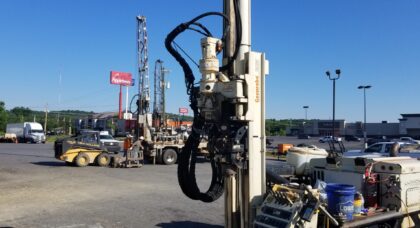Leaking Underground Storage Tank Services – Middle Tennessee
PM Environmental, Inc. (PM) was contracted by the Tennessee Department of Environment and Conservation (TDEC) to perform high-resolution site characterization (HRSC) for multiple sites in a location in middle Tennessee. The overall goal of the investigation focuses on identifying previously unknown contaminant sources and determining the extent, if any, of petroleum free product/LNAPL (Light Non-Aqueous Phase Liquids) or dissolved petroleum constituents.
The project offers a unique challenge to PM. “We are essentially back tracking a contaminated seep to its original source areas, so we are kind of going in reverse of our normal assessment techniques, working in this very mature karst setting in middle Tennessee just adds to the complexity of the project,” explained Greg Stephenson, Principal and Vice President at PM.
“This project is allowing us to use several assessment techniques to assess potential petroleum source areas which are manifesting themselves in groundwater seeps in a residential area,” said Stephenson. “Those include High Resolution Site Characterization, Stream Gauging and Hydraulic Monitoring, Karst Surveys, Multiple Site Simultaneous Dye Traces, Interim Corrective Actions using pressure injections of Bos200 directly into open bedrock boreholes and construction of treatment cells at specific seep locations.”
PM used Induced Potential (IP) and Electro Magnetic (EM) Geophysical Studies to aid in the siting and placement of open borehole bedrock wells. Other factors that went into well location were confirmatory soil samples analysis, prior knowledge of the site from TDEC file review, correlation of Near Surface Geophysics (NSGs) electrical resistivity, ease of accessibility on site, and as well as coordination from PM and TDEC staff. The total depth of the wells was advanced to at least five feet below the elevation of the known seeps located along a creek in the study area.
Once the wells were installed, down hole geophysics and camera logging were used to looked for fracture zones or preferential pathways. PM then used down hole packer testing to confirm preferential pathways and conducted pressure testing and sampling from those pathways using PM’s subcontractors that specialize in these techniques. Dye tracing was then conducted from potential source areas as well as specific injection points to determine if there was connectivity from a source to any impacted seep.
“If contaminants are discovered we then propose a discrete injection plan to inject Bos200TM (an activated carbon slurry infused with microbes and food source), into those impacted zones as an interim corrective action,” said Stephenson. “We are still conducting assessment activities in the study area and will have additional corrective action this coming year.”



